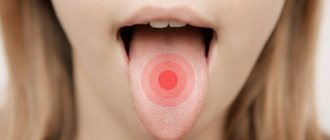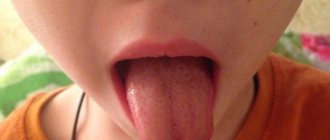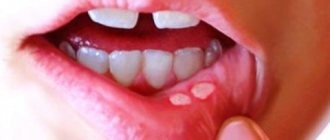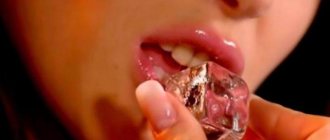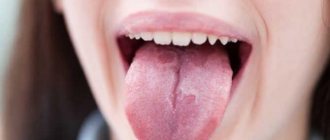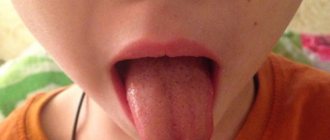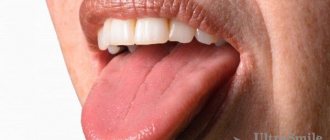Plaque on the tongue itself is not a disease, it is a symptom that reflects what is happening in the body. There are types of plaque on the tongue that indicate a disorder in the functioning of internal organs. These types of plaque are called pathological.
Author:
- Sadykhov Rahim Agalarovich
ENT pathology expert
3.64 (Votes: 14)
Plaque on the tongue itself is not a disease, it is a symptom that reflects what is happening in the body. In this regard, the statement that language is a mirror of our health is quite true. A slight transparent or whitish coating is normal for a healthy adult. It is usually noticeable after sleep and can be easily cleaned with a toothbrush. However, there are other types of plaque that are not so harmless and indicate a disorder in the functioning of internal organs. These are pathological types.
Pathological plaque can be different: the color ranges from thick white to black, dense and sticky in consistency, and has a bad odor. The structure of the language itself may also change. This is the first signal about the onset of the disease, so if you notice uncharacteristic changes in the appearance of your tongue, consult a doctor for a correct diagnosis. Indeed, in this case it is necessary to identify the root cause of this unpleasant manifestation and quickly begin to treat the underlying disease.
What can cause pathological plaque?
The main reason is a malfunction of the internal organs. However, there are two other possibilities: smoking and improper oral hygiene. For active smokers, a yellowish coating is a constant companion, which may not indicate anything bad about health other than the presence of a bad habit. If you don't brush your mouth properly, your tongue will be completely ignored. It is wrong to brush your teeth alone. Bacteria accumulate on the surface of the tongue; they also need to be removed. To clean the tongue, many toothbrush manufacturers make a special brush on the other side. There are also scrapers for the surface of the tongue.
If a person does not smoke and maintains proper hygiene, but there is still plaque, then this may be an indicator of the following diseases:
- Diseases of the digestive system (the most common cause) are ulcers, gastritis, diseases of the gallbladder, pancreas, and liver. Usually in such cases the plaque is accompanied by a persistent unpleasant odor that does not go away even after cleaning.
- Diseases of the respiratory system - tuberculosis, bronchitis, asthma.
- Infectious diseases - influenza, sore throat, ARVI, acute respiratory infections.
- Reduced immunity.
- Diseases of teeth and gums.
- Changes in acid-base balance due to medications.
History of the name of the disease
If the smallest filiform papillae on the tongue gradually atrophy and smooth out, due to which the surface of the muscular organ becomes as if polished, then glossitis can be suspected from this symptom. In general, the pathology is an inflammatory disease of the tongue. However, depending on the reasons for its appearance and the main symptoms, glossitis varies. For example, desquamative, rhomboid, folded. You will find what its most common varieties look like in the feature article on the website.
With non-infectious Gunther-Miller glossitis, the tongue becomes smooth
If the tongue becomes smooth, then, as a rule, we are talking about non-infectious glossitis Gunter-Miller or Gunter-Möller (in some descriptions of the scientific literature1). The pathology received its name in honor of the British physician William Hunter (in outdated pronunciation - Gunther) and the German surgeon Julius Otto Ludwig Möller, who were the first to describe the characteristic symptoms of the disease in their works. The first mentions of the syndrome are found in the literature of the distant 1851 and 1909.
In various sources you can find the following names and definitions of Gunter-Miller syndrome: Gunter's, Hunter's, hot, atrophic glossitis, crimson, smooth, polished or glossy tongue.
What color is the pathological plaque?
By the color of the coating on the tongue, you can determine which organ malfunction caused it:
| White | A light whitish coating that can be easily cleaned with hygiene procedures is the norm for an adult. A cause for concern is if the white coating is dense or has a cheesy structure and is not cleaned. This may be a sign of a fungal infection. Other reasons include: monotonous diet, lack of vitamins, poor hygiene, smoking, intoxication, wearing dentures, taking medications. |
| Grey | Sometimes the tongue becomes covered with a gray coating when taking antibiotics for a long time. Also accompanies diseases of the gastrointestinal tract. |
| Yellow | Often indicates liver disease (in such cases a bitter taste is felt in the mouth). It can also occur with diseases of other organs of the digestive tract, with viral diseases, with an excess of bile in the body. |
| Green | This is a rare occurrence. Most often it is an indicator of liver problems. |
| Brown | Occurs with disorders of the digestive tract, alcoholism and smoking, and abuse of brown foods (chocolate, coffee, black tea). |
| Orange | It occurs mainly with gastritis, due to the fact that gastric juice enters the oral cavity in large quantities. |
| Blue | It may appear due to problems in the cardiovascular system, kidneys, due to a lack of folic acid, iron, Vit C, Vit B12. It can also appear due to mercury and heavy metal poisoning. |
| Black | Appears in cases of liver dysfunction, lead poisoning, acute infections, Crohn's disease, acidosis. |
Why does my tongue hurt?
Physiological reasons
Pain in the tongue is often the result of minor injuries: superficial burns from too hot liquid, accidental biting, damage from hard pieces of food, fish bones.
Painful sensations are combined with numbness or, on the contrary, hypersensitivity. They disappear within a few minutes or hours, less often – days. Burning and sore tongue can also be caused by eating spicy foods, certain spices, or drinking strong alcoholic beverages. In people who smoke, the sensitivity of the tongue increases due to the constant effect of tobacco smoke on the mucous membrane, which leads to the frequent occurrence of pain under the influence of other irritants.
Traumatic injuries
More serious injuries occur due to biting the tongue during an attack of epilepsy, sports, or accidents. Abrasions and wounds in the form of teeth marks are found on the tongue. Depending on the severity of the damage, pain lasts from several days to 1-2 weeks. In patients with incorrectly selected orthodontic structures or poorly fitted removable dentures, pain becomes the result of chronic irritation of the tongue. With advanced caries, the organ is systematically injured by the sharp edges of the teeth.
Glossitis
Pain syndrome is not observed with all glossitis; it is more typical for infectious lesions. The inflammatory process of bacterial etiology is manifested by hyperemia, swelling, increased local temperature, aching, raw pain. With viral glossitis, blisters form, which subsequently open to form painful erosive defects.
Tongue pain
Abscess and phlegmon of the tongue
An abscess develops against the background of microtrauma or becomes a complication of bacterial glossitis. Characterized by rapid onset and progression of symptoms. Superficial abscesses are localized under the mucosa, usually in the back area. They represent an area of limited swelling with a painful thickening in the center. They are accompanied by sharp pain when moving the tongue, swallowing, and sometimes radiating into the ear.
Deep abscesses are located deep within the organ. They manifest themselves as hyperthermia, intoxication syndrome, in some cases – chills, enlarged regional lymph nodes, and excessive salivation. The tongue is so swollen that it can hardly fit in the mouth, making speech and breathing difficult. The pain is sharp, jerking, bursting, pulsating, aggravated by movement, swallowing, or touching.
In patients with phlegmon, the area of purulent inflammation is not limited, quickly spreading to the entire tongue, floor of the mouth, and neck. Febrile fever, chills, and regional lymphadenitis are observed. The pain syndrome is intense, diffuse, depriving sleep. Eating is very difficult or impossible. Speech is slurred. Due to the blockage of the airways due to swelling of the soft tissues of the oral cavity and oropharynx, attacks of suffocation develop.
Oral candidiasis
Painful sensations are more often observed in acute candidiasis, but are not typical for the chronic form of the disease. Children, old people, and weakened patients with severe somatic pathologies suffer. A loose or dense milky-white cheesy coating forms on the tongue, spreading to the palate, cheeks, and lips. When plaque is removed, a bleeding, eroded or macerated mucous membrane is exposed.
When eating food, pain and burning occur. In the absence of therapeutic measures, transformation into atrophic candidiasis is possible. The tongue becomes shiny, fiery red. The papillae atrophy. The mucous membrane of the oral cavity is swollen, hyperemic, dry, thinned. Patients complain of severe pain in the affected area. Plaque is not detected or is insignificant.
Glossalgia
Glossalgia is a pathology accompanied by unpleasant sensations in the tongue in the absence of organic changes. Occurs in diseases of the liver and gastrointestinal tract, vascular, endocrine diseases, pathologies of the central and peripheral nervous system. Painful sensations without clear localization, diffuse, have a burning, pinching or sore character, are more pronounced in the area of the tip and sides, less often appear on the root and back of the tongue. May be episodic or regular. As a rule, they are combined with neurotic disorders.
Xerostomia
Pain in the tongue is a concern in the final stages of the disease. Against the background of complete inhibition of the function of the salivary glands, glossitis develops. Constant dryness of the mucous membrane leads to the formation of erosions and ulcers. Painful sensations intensify when talking, while eating, and are combined with constant dry mouth. Patients with xerostomia may have multiple caries.
Neuralgia
Pain in the two anterior thirds of the tongue is characteristic of damage to the third branch of the trigeminal nerve (n.mandibularis), combined with painful sensations in the chin, lower jaw, lower lip, gums, and buccal mucosa. The pain syndrome is paroxysmal in nature and is a series of impulses resembling an electric shock. It is provoked by cold influences, shaving, chewing, speech, laughter.
With neuralgia of the glossopharyngeal nerve, pain appears at the root of the tongue, from where it spreads to the tonsils, soft palate, pharynx, and sometimes to the ear, eye, and lower jaw. The attack is provoked by swallowing, chewing, yawning, coughing, talking, and is accompanied by dryness in the throat, which at the end of the paroxysm is replaced by increased salivation.
Neuralgia of the hypoglossal ganglion is characterized by pain in the anterior parts of the tongue, the sublingual zone: boring, burning, pulsating, paroxysmal. Lasts from a few minutes to 1 hour. It radiates to the lower jaw, temple, back of the head, side of the neck, shoulder girdle, sometimes to the arm, upper chest. It intensifies when talking, eating, especially rich or spicy food.
Anemia
Pain in the tongue is typical of pernicious anemia and is caused by glossitis. The tongue becomes “varnished” and acquires a crimson color. Weakness, tachycardia, and dizziness are observed. Characteristic symptoms are shortness of breath, pale skin, puffiness of the face. Loss of appetite, hepatomegaly, and stool instability are detected. Neurological disorders are detected: muscle weakness, gait changes, stiffness, numbness of the limbs.
Sometimes painful sensations in the tongue area occur with iron deficiency anemia. Glossitis is combined with dysphagia, angular stomatitis, and atrophic gastritis. The prevailing symptoms are weakness, tinnitus, dizziness, shortness of breath, and palpitations. Dry skin, deformed nails, and hair loss are noted.
Other reasons
Pain in the tongue is sometimes detected in the following conditions:
- Allergy
. Soreness, paresthesia, severe itching are caused by food allergies, less often - by a reaction to plant pollen or animal fur. Combined with sneezing, lacrimation, swelling of the mucous membranes. - Initial stages of cervical osteochondrosis.
Vague pain sensations in the tongue are complemented by awkwardness, restrictions in neck movements, and pain in the neck. - IHD.
Pain in the tongue, oral cavity, and lower jaw can be observed during an atypical course of an attack of angina pectoris or myocardial infarction.
Oral examination
Diagnostics
To establish a complete picture of the state of the body, the doctor determines the color of the tongue, its structure, position, motor functions, and possible other pathologies in the oral cavity. Among the laboratory and instrumental research methods aimed at clarifying the characteristics of plaque and the reasons for its appearance, the following may be prescribed:
- general and biochemical blood test;
- sowing on flora from the surface of the tongue;
- determination of antibodies to the bacterium Helicobacter pylori;
- Ultrasound of internal organs;
- fibrogastroduodenoscopy;
- scatological research.
If you are concerned about the condition of your tongue, plaque on it, pain, unpleasant odor, contact the ENT doctors of our clinic. High-precision equipment and the experience of our specialists allow us to quickly make correct diagnoses and prescribe treatment.
Treatment of the disease: what doctors usually prescribe
For Gunther-Miller glossitis, doctors prescribe complex treatment.
If Gunter's glossitis is not treated, in advanced cases this can lead to the disappearance of the papillae on the tongue and a reduction in the muscle organ itself, speech impairment, problems with breathing and adequate food intake. All this will significantly worsen the quality of life. In addition, advanced disease is fraught with phlegmon of the tongue and purulent melting of tissue, which does not exclude sepsis and even death.
Drugs that help eliminate symptoms of pathology
Local antiseptics “Furacilin”, “Chlorhexidine”, “Miramistin”, and chamomile decoction help to reduce swelling of the tongue and signs of inflammation, remove ulcers and prevent the appearance of new ones. To eliminate pain, it is usually recommended to use non-steroidal anti-inflammatory drugs, for example, Nurofen.
"Chlorophyllipt" can also be used for rinsing
In order for wounds on the tongue to heal faster and delicate tissues to regenerate successfully, doctors prescribe retinol solution, vinylin, Solcoseryl, and rosehip oil to patients for local treatment of the affected areas.
During illness, you must follow a special diet. You should avoid spicy, hot and smoked foods. There is no need to season food with spices. It is better to give preference to boiled and stewed dishes with a soft or liquid consistency. Doctors also advise drinking more fluid in the form of plain water, herbal teas, berry infusions and fermented milk drinks.
Medicines to replenish vitamin deficiencies
Here we are not talking about classic vitamin and mineral complexes, which are presented in a wide range in pharmacies and are available to any person. If you suspect you have anemia or pellagra and simply buy such a drug, you will do little to improve the situation.
What is usually prescribed? For anemia, as a rule, injections with vitamin B12. Each age has its own dosage. They must be placed within 4 weeks, after which maintenance therapy is recommended every 6 months and follow-up for 2 years. Doctors note that some patients develop iron deficiency anemia during treatment with vitamin B12, which is subsequently eliminated with iron supplements2.
For anemia, vitamin B12 injections are prescribed
Sprue may require taking tetracycline drugs, as well as injections of vitamin B12 and folic acid. For pellagra, niacin or nicotinamide is prescribed in combination with B vitamins (thiamine, riboflavin) and vitamin C.
During treatment, as well as after it, the patient is not recommended to take actions that lead to increased consumption of B vitamins: physical and emotional overload, smoking, drinking alcohol.
Drug therapy
In order for a smooth tongue to regain its healthy appearance, doctors may prescribe, in addition to the measures listed above, the use of antibiotics, antidepressants, immunostimulants, sedatives and hormonal drugs. The liver of medications and further actions will be determined by what causes the pathology.
Notice
: Undefined variable: post_id in
/home/c/ch75405/public_html/wp-content/themes/UltraSmile/single-item.php
on line
45 Notice
: Undefined variable: full in
/home/c/ch75405/public_html/wp-content /themes/UltraSmile/single-item.php
on line
46
Rate this article:
( 3 ratings, average: 5.00 out of 5)
language
- Lyulakina E.G., Chizhov Yu.V. Oral diseases in elderly and senile people // Clinical gerontology, – 2011.
- Rumyantsev A.G., Maschan A.A. Federal and clinical guidelines for the diagnosis and treatment of anemia caused by B12 deficiency, 2014.
Expert “Smooth Gunter's tongue can be a symptom of deficiency conditions that often occur against the background of bacterial and fungal lesions of the oral cavity, helminthiasis, unbalanced nutrition, HIV and syphilis, gastritis, cirrhosis of the liver, cardiovascular pathologies, systemic and genetic abnormalities (for example, syndrome Down, Sjögren's syndrome), blood diseases." Dentist-therapist Elena Vladimirovna Orlova
Consulting specialist
Varlamova Tatyana Vitalievna
Specialization: Dentist-therapist Experience: 6 years
Surface type
In general, the disease can affect different areas of the mucous membrane, but the superficial variety affects only its upper layer. Superficial glossitis of the tongue can be seen in the photo.
The photo shows superficial glossitis of the tongue
It all starts small - the catarrhal stage of the disease. First, the mucous membrane becomes swollen, and upon visual inspection it is noticeable that it is covered with a dense coating. If treatment is not started during this period or the pathology is not completely cured, then an ulcerative form develops - small painful aphthae appear on the mucous membrane, which can bleed.
What is glossitis of the tongue? This is a disease that, like many other dental pathologies, can occur in acute and chronic stages. It can have pronounced symptoms or a sluggish inflammatory process that will go unnoticed for a long time, undermining your health. That is why it is so important to undergo timely preventive examinations with a dentist and therapist.
Traditional medicine at the service of the people
Here is a selection of recipes for solutions, the use of which will help disinfect, heal wounds and reduce pain:
- A decoction of bedstraw helps to cope with tongue pain . Brew 1 tablespoon of dried herb with boiling water, leave for half an hour, strain the resulting mixture. The decoction is suitable for both rinsing and internal use.
- Sage tincture is an assistant in the fight against pain during the treatment of oral injuries. By brewing 2 tablespoons of the substance with half a liter of boiling water and letting the infusion “rest” for 30 minutes, you will get an excellent antimicrobial and anti-inflammatory medicinal drug. Rinse frequency: 5-11 times a day.
- Pour 1 tablespoon of chamomile 250 ml of boiling water and let it brew. Use the strained solution after meals and before bed to heal wounds and relieve inflammation.
- St. John's wort tincture is a panacea for pain caused by a tongue injury. Use 40% alcohol and dried herb in a ratio of 5 to 1, respectively. Add 30-40 drops to 250 ml of water and rinse your mouth.
- Finding potatoes in a cellar or drawer is not difficult, but peeling them is a matter of two minutes. Feel free to use sliced raw vegetables to relieve pain from burns.
Reasons for the development of pathology
Glossitis is an external manifestation of diseases of internal organs caused by a deficiency of certain vitamins. Key development factors:
- Pernicious anemia is caused by a reduced level of vitamin B12 and folic acid. A decrease in the absorption of substances occurs as a result of long-term drug therapy, gastrointestinal disorders, oncological diseases of the digestive organs, autoimmune diseases, and congenital metabolic pathologies. Vegetarians, nutritional deficiencies, or alcoholism may have mild deficiencies.
- Pellagra is a disease that develops due to deficiency of nicotinic acid (B3, PP). Patients with nutritional deficiencies are susceptible. Provoke the development of stomach diseases, UV irradiation, antibiotic therapy.
- Sprue – manifested by gastrointestinal dysfunction. Identified in patients who visited endemically unfavorable areas.
Prevention of tongue diseases
To reduce the risk of diseases of the tongue itself and other organs, you need to monitor your diet, daily routine, and have less contact with infectious patients. Caring for the tongue itself should be no less thorough than caring for your teeth.
Accumulating plaque, especially in sick people, is a place for mass reproduction of bacteria and fungi. If it is not removed in time, it will become a source of infectious pathogens that can penetrate any part of the body.
When cleaning the oral cavity, it is useful to use toothbrushes with a ribbed back surface to clean the tongue from plaque, or special spoons and scrapers. But they must be used carefully so as not to damage the taste buds and mucous membrane. After cleaning, it is advisable to use pharmaceutical rinsing solutions or prepare homemade herbal decoctions.
Malocclusion
Incorrect bite formation leads to permanent injury to the mucous membranes of the mouth and tongue. As a result, the muscle organ swells and increases in size. Due to constant biting, teeth marks are left on the sides of the tongue.
The disease can be cured only after correcting the malocclusion. To do this, the doctor selects a design to straighten the dentition. For minor violations, patients are prescribed to wear orthodontic plates, trainers, and silicone trays. In case of more serious pathology, the defect is corrected using braces. The course of treatment can take from 3 months to 2 years.
Biting your tongue - everyone knows this
Biting the tongue, cheek or lip is accompanied by painful sensations, as damage to the mucous membrane occurs.
Obviously, the initial goal after a bite is to reduce pain. So, what should you do if you bite your tongue, what and how to relieve pain and inflammation?
The main rule is to remain calm. Calm down and try to come to terms with the pain, because tantrums and tears will not help heal the damage.
And then you should do the following:
- Be sure to stop bleeding , if any. An elementary solution would be to repeatedly rinse with cold water: it will help narrow the blood vessels and reduce bleeding activity. A worthy alternative would be a piece of ice.
- Cotton swabs soaked in 2% Lidocaine help in the fight against painful sensations . Another variation to reduce pain is eye drops with an anesthetic - Tetracaine, Alcaine.
- It is important to disinfect the entire oral cavity : brush your teeth thoroughly and rinse your mouth.
- Maintain regular rinsing : it is advisable to wash away the remains of eaten food after each meal.
- Use antiseptics such as Antiangin, Trachisan, Furacilin in the form that is optimal for you: spray, lozenge or solution.
- Avoid eating rough, cold or hot foods . During the restoration of the oral mucosa, it is advisable to create a daily menu of liquid soft foods at medium temperature: purees, soups.
- Avoid cold foods - ice cream, frozen juice and other foods with temperatures below zero - they slow down the healing process.
- Take a course of vitamins to help restore damaged areas. The optimal solution would be to include vitamin C and group B in the diet.
Do not forget to adhere to sanitary and hygienic measures: do not reach into the oral cavity with dirty hands, do not put pressure on the resulting injury.
Never pour iodine or brilliant green or peroxide into a wound: give preference to treating the environment around the injury. Antibiotics can only be used as prescribed by a doctor.
In practice, there are cases of tongue biting. In such a situation, it is important to remain cool, act quickly and in an organized manner: place the “particle” in a bag filled with ice and go to the hospital. To relieve painful sensations, it is permissible to ingest cold food: suck ice cream, frozen juice, ice, drink water.
Vitamin deficiency
If there is a lack of vitamins B and D in the human body, the surface of the tongue dries out, cracks, becomes inflamed, becomes coated, and bad breath appears.
When an allergic reaction to vitamins occurs, the muscular organ swells, and dents from the teeth are clearly visible on its lateral surfaces. With a lack of vitamin B₃, the organ cracks, painful sensations appear, and a burning sensation occurs while eating. If an infection occurs, an acute inflammatory process develops, purulent ulcers form, and the person’s well-being worsens. To treat the disease, it is necessary to compensate for the lack of vitamins in the body.
Condition of the mucous membrane of the tongue
Changes in the condition of the mucous membrane of the tongue are an indicator of pathogenic processes in the body, and therefore in medicine the characteristics of the tongue are used to diagnose diseases.
An excessively dry surface of the mucous membrane of the tongue indicates, first of all, dehydration. It can also be caused by peritonitis, intestinal obstruction, hyperthermia in infectious diseases, as well as a long stay in a coma. With prolonged constant dryness, the appearance of cracks in the tongue is possible. A dry tongue with numerous cracks is also characteristic of diabetes mellitus, and if left untreated in a diabetic coma, the speech organ becomes brownish-brown.
Desquamative
Glossitis on the tongue, as in the photo, is scientifically called desquamative, migratory or exfoliative1, but popularly this disease is better known as “geographic tongue”, because in appearance it resembles a geographical map with clearly defined continents in the form of bright red areas of the affected area. mucous membrane.
The photo shows the geographic language
The disease most often develops in the fair half of humanity, more often during pregnancy due to metabolic disorders, when the expectant mother lacks vitamins and useful nutritional minerals. Also, pathology often develops against the background of chronic lesions of the gastrointestinal tract, burns of the mucous membrane and acute allergic reactions.
It is worth knowing that this form rarely develops into an acute stage, so if characteristic signs appear, you should not wait for accompanying symptoms, such as pain or swelling - you should immediately consult a doctor.



